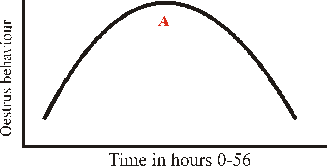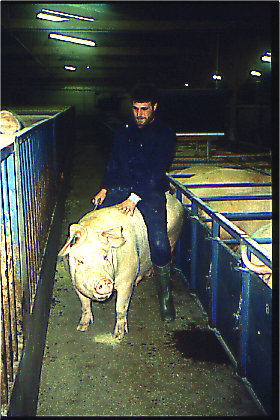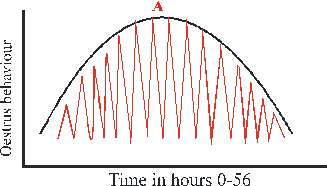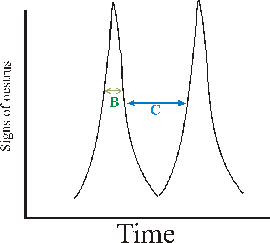Oestrus Behaviour Patterns
Text Book:
| If this is correct
the sow will stand still to the point A where she does not move
for several hours. This would then wane and the animal starts
moving again. |
|
 |
| Clearly this does
not occur. The graph above describes a "population" of
individual sows. It does not describe the events in an
individual |
 |
The Individual:
The individual becomes more and then less
interested in the boar. The pattern of oestrus behavior is actually
represented by the following graph

The sow switches in and out of
oestrus
What are the detail of events around point
A?
| Lets examine the events around
point A
in some detail: If we accept the
following:
- the sow is in the middle of oestrus
- the signs of oestrus wane in intensity and
the sow is not always responsive
- all sows and boars are individuals
Therefore the following questions can be
asked:
- How long is the sow in heat i.e. time
length B?
- How long is the sow not in heat i.e. time
length C?
|
|

|
Research in this area is still limited, however, based on work in
gilts and personal experiences
length B the gilt is in heat for
10-15 minutes. This is the time the sow will allow boars
to mate with them. It is interesting to consider who initiates the
end of mating. In many cases it is the sow who by fidgeting and
moving around finishes mating with the boar falling off.
Length C is more
controversial and appears more variable. However, the
gilt is not in heat for a time interval of 45
minutes. The time length partially depends on the degree
of "satisfaction" the sow receives during mating. There is also a
degree of submission with a keen boar.
What is the significance of these findings?
Take 4 gilts in a pen, W,
X, Y, Z and their position in the estrus behavior curve
is as shown below:

A boar is placed in their pen. Which of the gilts
demonstrate good standing heat?
Gilts Y and
X appear in good standing heat.
Gilt W rapidly joins them. Gilt
Z on the other hand is
uninterested in the boar. Note it is possible to miss even
W if the boar by this time is
occupied with X and
Y and the stockperson is too busy.
How can we encourage the sows and gilts to
demonstrate good standing heat when the stockperson is observing the
sows?
Stockperson's tasks:
- Know the signs of oestrus
- Spend more time observing heat. Examine for
heat 3 times a day between weaning and breeding, especially days
4-6 post-weaning will dramatically improve the detection of
standing heat.
- Ensure you are not distracted during estrus
examination. It is vital that stockpeople have a clear mind when
heat checking. For this reason only mate am while heat checking at
other times of the day.
- Heat check in cooler parts of the day
In the winter 8.00, 12.00 and 16.00
In the summer 7.00, 16.00 and 20.00 would be more suitable
In the extreme heat of the day the behavior of the female and boar
will be subdued
- Heat check with adult boars who salivate and
produce good quantities of pheromones
- Use pheromone products
- Ensure the breeding area is well lit, 500 lux
required
- Ensure the sows and gilts are housed in ideal
environments i.e. draught free
Enhancing the females
response
- Remove the boar from sight and sound for 1 hour
prior to heat checking. The boar must be removed by at least 10
meters
- By removing the boar the behavior signs subside
and when the boar is introduced more sows are interested. The
peaks become much lower and length out exaggerated
- Sows and gilts only require 20 minutes a day
boar exposure to produce good signs of oestrus but the ideal boar
contact is full body and nose contact.
- Ensure an ideal environment at a minimum of 2.8
m2 per gilt/sow
To maximize the chance of reproductive success
involves serving a sow only when she is in good standing heat, where
she achieves a climax and oxytocin driven contractions of the
uterus, to transport the sperm through the uterus to the safety of
the oviduct. |